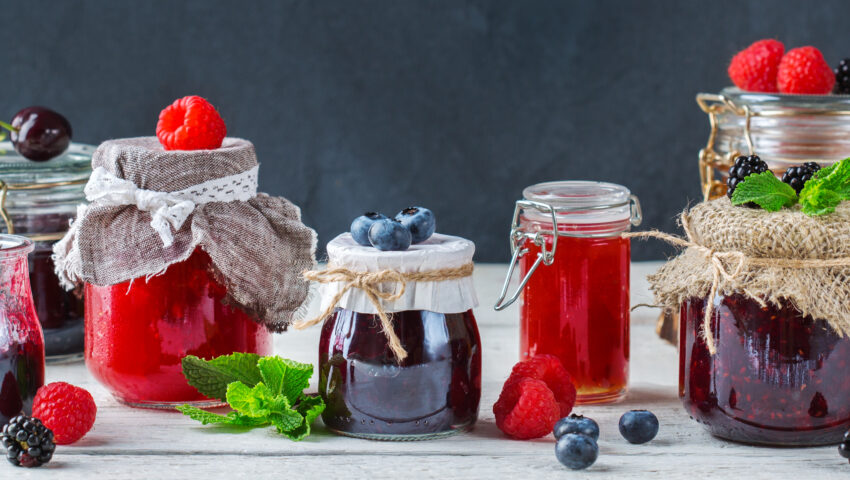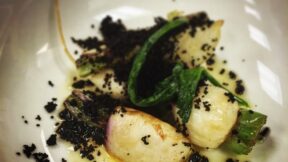Blogs
Pickling and preserving the BM way…

There’s nothing that says summer more than jam and chutney-making! I have been taking my boys out to ‘pick-your-own’ farms during lockdown and I have a cupboard full of jams and chutneys to keep us going through the winter. It’s not hard to do, so I thought I would share some of my chef colleagues, Gareth Ruck’s favourite preserving recipes. He’s got suggestions for different flavours and spices to inspire you with tips for making perfect chutney. We haven’t forgotten the sweet side of preserving – learn how to make perfectly- set jams and a delicious recipe too. No more over-sweet or under-set jams!
And pickles aren’t just used in the kitchen, we’ve got a great dill pickle martini recipe for you.
Jams, chutneys, fermentation and pickling. All of these methods of preserving either use the addition of salt, sugar or vinegar to slow down the formation of bacteria that can make the food spoil. Here we are focusing on preserves in the form of jams and chutneys.
Jams
Jams are so rewarding to make yourself at home, the difference between store bought and homemade is massive. They are simple to make, you only need 4 ingredients to make jam, fruit, sugar, pectin and an acid.
There are often debates or questions around what type of sugar to use. Plain granulated or jam sugar (which has pectin added already) are the best. Dark sugars can overwhelm the flavour of the fruit you are using. Natural sweeteners like honey and maple syrup have a lower burning temperature and won’t allow the jam to set.
Tips to ensure that your jam is successful.
- To be considered a jam, it needs to be 60% sugar including the natural sugars that are in the fruit.
- The cooking temperature needs to be taken to 104.5c, this ensures the sugars are completely cooked and the jam will set.
- The easiest way to check this is by using a thermometer.
- If you do not have a thermometer, there is the saucer in the fridge method. Place a side saucer in the fridge and chill, take a spoonful of hot jam and drop onto the saucer, place in the fridge and allow to cool, when touching it check if it wrinkles, this will show if it is setting.
- Use fruit that is either just ripe or slightly under-ripe. It must be dry so as not to add any extra unnecessary moisture to the cooking process.
- Pectin occurs naturally in fruit, these levels vary according to the type of fruit. Fruit like quince, apples and gooseberries have naturally high levels of pectin. Strawberries and other soft fruits generally have a low amount.
- There are 2 options to combat this, you can add additional pectin in the form of jam sugar or powdered pectin. Another method is to mix low pectin fruits with high pectin fruits like apples and blackberries. You can increase the amount of natural occurring pectin by layering the fruit in sugar which will allow the pectin to be accessed more easily.
- You can make jam with any fruit. A general rule of thumb is to use equal quantities of fruit and sugar by weight, with the addition of an acid like lemon juice. The lemon improves the setting ability of pectin, fruit with lower pectin levels require more acid.
Storing and Jarring
Pour the hot jam carefully into your sterile jars and fill them to the brim, this will reduce the amount of moisture that can form while cooling and also the amount of oxygen present. Then cap them, the heat should seal the bottle and create a vacuum. Keep an eye out for any mould or yeasts that might grow on it.
Chutneys.
Whenever there are fruit and vegetables looking a bit sad in the fridge, they’re great to use in a chutney. This also means produce isn’t wasted and you’ll have homemade condiments to use that will last for a long time. This is one of the most versatile ways to use up items and give slightly sad looking vegetables and fruits an amazing new lease of life. The ability to customise is only limited to your imagination.
The Key Ingredients
These are sugar, vinegar, spices and any combination of fruit and vegetables. There are no real rules around it, you can use any type of sugar you want – for example brown sugar gives a richer flavour. For the vinegar you can use malt or the more expensive balsamic or wine based vinegars. Only keep in mind the amount of sweetness that they contain so you can balance your flavours. Balsamic has higher sugar content that malt vinegar.
Be as imaginative as you want with your spices – ginger, allspice, nutmeg or cinnamon, everything seems to work well, find flavours you enjoy and experiment. You can always add more spice but not take it away, so always taste as you are cooking and adjust as you go until you get the flavour you want. This will means you won’t overwhelm the chutney by adding to much spice initially
What to drink:
While we have been focussing on pickling and preserving food, it would be a shame to not mention that it is also amazing in drinks. While pickleback shots and pickle infused drinks are popular in America, they are slowly gaining traction on our shores. This week we will be showing off the amazing dill pickle martini, a twist on the classic dirty vodka martini. First you will need to make your pickle infused vodka.
I hope Gareth’s preserving recipes inspire you to make some jams and chutneys. Next week I will share our ideas and recipes for fermentation and pickling (which is one of my passions).



